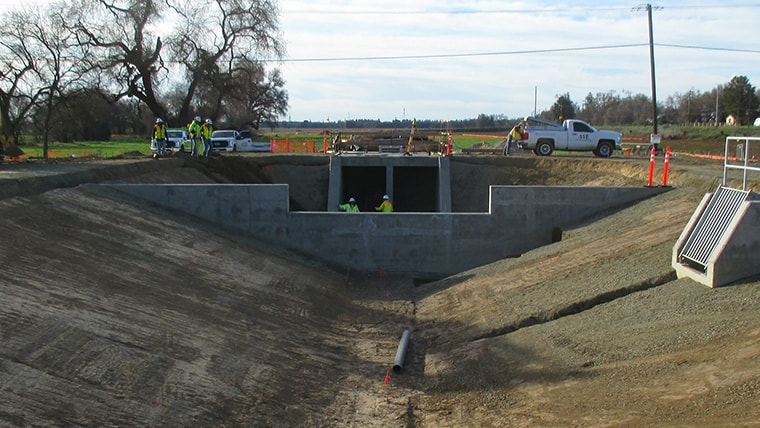As part of the American River Common Features Project in California, the U.S. Army Corps of Engineers (USACE) Sacramento District is performing seepage remediation for the levees along the entire Natomas Basin. To accommodate the levee improvements, three miles of the Riverside Canal had to be relocated. This main irrigation canal services approximately 3,000 acres of farmland.
The design of this relocation was executed by the Sacramento River East Levee Reach B design team, which included USACE design engineers and design engineers from local stakeholders including the Sacramento Area Flood Control Agency (SAFCA) and the Natomas Mutual Water Company (NMWC). This partnership between USACE design engineers and local stakeholder engineers combined experience and skillsets to make the project a success.
As part of this design team supporting SAFCA and NMWC, I along with other Mead & Hunt engineers were able to work closely with Sacramento District’s engineers while designing the Riverside Canal relocation, the pump station work, and all the borrow sites for levee construction. We also provided design direction to the USACE design team for all irrigation and drainage system design and related levee design.
Due to physical site constraints and changing irrigation needs, portions of the canal will be replaced with a pressure pipeline, along with a variable pressure, automated booster pump station for servicing field crops and drip irrigation. The design extends the Riverside Plant levee discharge pipe and Riverside Canal and adds lift station sump/pumps, large diameter HDPE pipelines and regulating outlets.
The work included pump testing and investigations for facility and equipment sizing. Another key feature was working with the USACE geotechnical team to analyze the borrow materials sampling and laboratory testing to develop a plan to provide suitable levee embankment and seepage berm material. The borrow sites were designed as habitat mitigation features, with a secondary groundwater supply.
As a Federal flood protection project with State funding, the work is subject to both the National Environmental Policy Act (NEPA), including SHPO, and California Environmental Quality Act (CEQA). Design team efforts included associated environmental assessments, wildlife and habitat assessments and historical/archeological assessments. The team developed mitigations and avoidance measures, which were incorporated into design. We also developed designs for project mitigation habitat, working closely with local conservancy.
What is especially interesting was that many of the plans, specifications, estimates and supporting documentation were prepared by non-Federal stakeholder engineers for a construction by the USACE. The project is currently under construction, with stakeholder engineers providing engineering support to the USACE, including responses to request for information, submittal reviews, and providing technical advice to the USACE team. Stakeholder engineers are also responsible for obtaining approvals from all local stakeholders and will lead all well drilling testing and operational testing of pumping facilities as well as testing of all mechanical, electrical, instrumentation and communication systems.
The success of this project showcases the value partnering with both Federal and non-Federal local stakeholder engineers can bring to a project process. Through combining experience of USACE and stakeholder engineers, this unique project is well underway to provide benefit to the local community for years to come.



